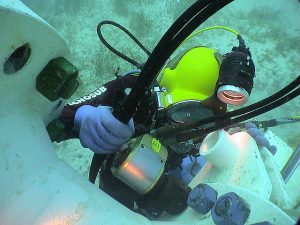16 May 2018–There are more than a million kilometers of underwater telecommunication cables lining the world’s ocean floor. Scientists would like to outfit those cables with environmental sensors—including seismometers—to improve the speed and success of tsunami warnings and to create better models of the Earth’s interior.
At the 2018 SSA Annual Meeting, researchers discussed these possibilities and others as part of the SMART (Science Monitoring And Reliable Communications) Cables Initiative. The initiative’s international Joint Task Force, formed in 2012, has proposed adding temperature, pressure, and acceleration sensors to the signal repeaters spaced every 50 to 75 kilometers along future cables as they are replaced and expanded.

When implemented, these new sensors will vastly improve the seismic coverage of the planet, since the majority of current seismic stations are located on land and two-thirds of the Earth is covered by oceans, said Los Alamos National Research Laboratory scientist Charlotte Rowe. Rowe presented a poster at the meeting showing that SMART cables could improve modeling of P and S-seismic waves, compared to models based only on land data. Better spatial coverage could help pinpoint the source and strength of earthquakes as well as provide more accurate models of the Earth’s subsurface structures, she said.
Bruce Howe, University of Hawaii oceanographer and chair of the Joint Task Force, also discussed the SMART cable initiative at the meeting. He said the sensors could help monitor tsunamis and sea level rise and ocean circulation as well.
At the moment, the initiative is focusing on raising money to develop either a pilot project with existing telecommunications cables or a “wet demonstration” of SMART cable capabilities, said Howe. “We’re now focusing on testing not on a global scale, but on a smaller system, likely the Pacific Rim area where the tsunami risk is high, and developing countries in island states are concerned also about climate change and sea level rise.”
“We have to demonstrate in our pilot that the science side of the system doesn’t interfere with the telecom side of the system,” he added. “There is a modest amount of engineering to be done, but we think it is very tractable.”
Howe said there have been recent proposals to add the scientific sensors in new telecommunications cables running between Tahiti and Samoa, and Ecuador to the Galápagos Islands, among other regions.
